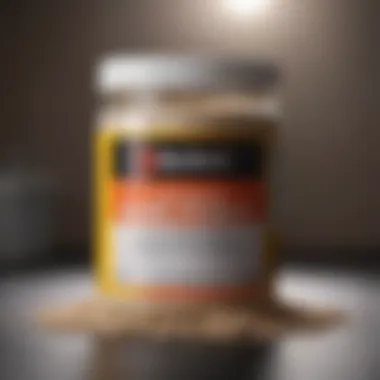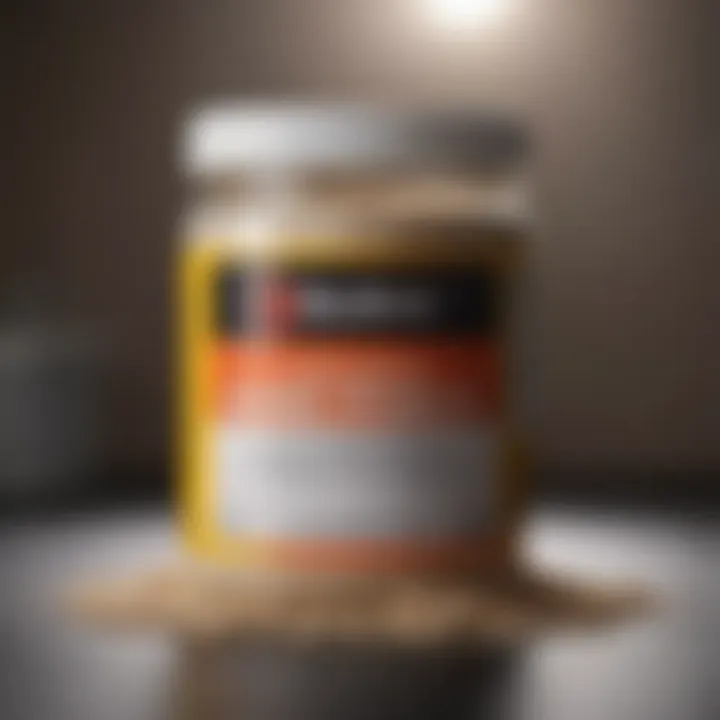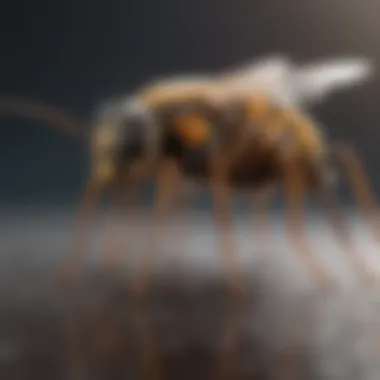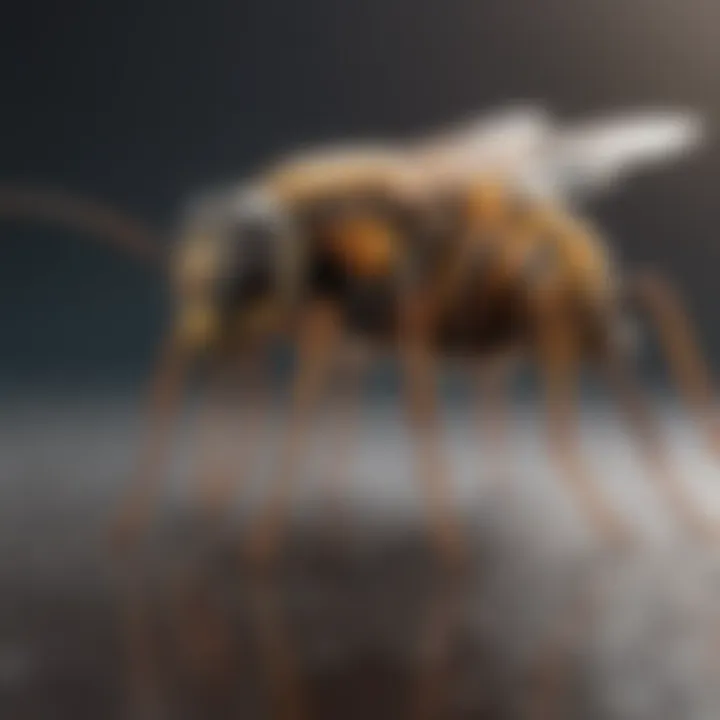Effective Pest Control with Boric Acid Powder


Intro
In recent years, pest control has become a significant concern for homeowners. Various options are available, each with its own merits and pitfalls. Among these options, boric acid powder stands out due to its effectiveness and relative safety when properly used. Understanding its role in pest management is crucial for those seeking eco-friendly solutions.
Boric acid is a naturally occurring compound that can disrupt the biological functions of various pests, primarily insects. This article provides a comprehensive overview of how boric acid powder can be effectively employed to manage pest populations in a variety of settings. We will examine its efficacy, safety, and methods of application, as well as compare it with alternative pest control methods.
This exploration is particularly relevant for housewives and homeowners, who often seek reliable and safe options to combat common household pests while being mindful of environmental impacts. Moreover, as urban living continues to increase, knowledge of effective pest control strategies becomes essential for maintaining comfortable and clean living spaces.
In this article, we will cover the following topics to provide a holistic understanding of boric acid powder in pest control:
- Understanding the Pest
- Pest Prevention Strategies
- Control Methods
- Identification
- Life Cycle
- Environment Modification
- Physical Barriers
- Chemical Control
- Biological Control
The importance of understanding the life cycle and behavior of pests cannot be understated. By recognizing these factors, we can make informed decisions about pest management strategies that align with our goals of safety and efficacy.
Preface to Boric Acid Powder
Boric acid powder is an effective tool in the realm of pest control. This section lays the groundwork for understanding its purpose and significance. The importance of boric acid extends beyond mere pest elimination; it encompasses safety, environmental impact, and cost-effectiveness. By understanding its composition and historical application, homeowners can make informed choices about pest management.
Definition and Composition
Boric acid, chemically known as hydrogen borate, appears as a colorless, odorless powder. It is composed of boron, hydrogen, and oxygen, delivering a unique mix of properties that repels and kills various pests. When ingested or manipulated by insects, it disrupts their digestive function and can lead to dehydration. This mechanism renders boric acid a potent agent in pest control strategies.
In practical terms, boric acid is available in several forms, including powder, tablets, and solutions. The powder is particularly useful for targeted applications in hard-to-reach areas, making it a preferred choice for homeowners. The composition also dictates how it interacts with various insect species, further enhancing its effectiveness.
Historical Use in Pest Control
The historical use of boric acid in pest control dates back to the late 19th century. Initially, it was recognized for its antifungal properties and later began being employed against pests, such as cockroaches and ants. Over the decades, boric acid gained acceptance as a safer alternative to harsher chemicals.
Throughout its history, boric acid has undergone extensive research, which confirmed its efficacy and low toxicity to humans and pets. Many households have turned to it for pest management. Its use can be traced across various cultures, solidifying its place in domestic pest control strategies. By understanding its past, we appreciate its continued relevance in modern pest management.
Mechanisms of Action
Understanding the mechanisms of action is vital when considering boric acid powder as a pest control strategy. This section delves into how boric acid interacts with pests on a biological level, shedding light on why it can be an effective choice for homeowners. The readers will gain insights into not just the functionality of boric acid but also how it can strategically be applied to maximize results while maintaining safety and environmental considerations.
How Boric Acid Affects Insects
Boric acid acts as an insecticide by disrupting the normal functioning of pests like cockroaches, ants, and other unwanted insects. When insects come into contact with boric acid, it affects their exoskeleton, leading to dehydration. In essence, the powder has abrasive properties that can cause physical damage to the outer shell of insects. This is one of the key reasons for its effectiveness against a variety of pests.
Moreover, when ingested, it disrupts their digestive process. This dual-action method explains why boric acid is often regarded as a long-term solution. It does not merely kill pests upon contact but also affects those that eventually consume contaminated substances. Thus, even those insects that have not directly interacted with boric acid powder can be impacted, as they may ingest it when feeding on contaminated surfaces or materials.
It's important to note that boric acid is slow-acting. While this can be frustrating for immediate results, it allows for the possibility of baiting: pests may carry the poison back to their colonies, affecting many other insects. This method of indirect action amplifies the effectiveness of boric acid powder in pest control.
Application Methods


Applying boric acid powder adequately is crucial for achieving desired results. There are several methods to consider, each with its specific advantages.
- Dusting: Using a dust applicator can help distribute the powder in hard-to-reach places, which is advantageous for targeting pests hiding in cracks and crevices. This method allows for a fine layer that remains effective for a longer period.
- Baiting: Creating bait stations that combine boric acid with attractive food can entice insects. By mixing boric acid with sweets or proteins, it attracts pests to feed on the bait, ensuring they consume the poison. This method is particularly effective for ants and cockroaches.
- Sprinkling: Simple sprinking in areas of activity can also be effective. It is best to apply in corners or near entry points where insects may travel regularly.
- Moisture treatments: In humid areas, mixing boric acid with a bit of water before application can increase effectiveness. This creates a thicker paste that clings better to surfaces. However, be cautious with moisture treatments, as bait should not be too wet as insects may avoid it.
When applying boric acid, always wear protective gear, such as gloves and a mask. Avoid using excessive amounts; a thin layer is usually sufficient. The proper application ensures that you target pests effectively while minimizing unnecessary exposure to humans and pets.
"Boric acid can be an effective pest management tool when applied correctly, and one should always follow the recommendations for safe usage."
Types of Insects Targeted
When considering boric acid powder for pest control, understanding the types of insects that can be effectively managed with this method is crucial. Different pests exhibit varied behaviors and physiology, which influences how boric acid impacts them. Knowing which insects are susceptible to boric acid allows homeowners to tailor their pest management strategies effectively. Additionally, focusing on specific target insects helps in applying boric acid more accurately, maximizing its benefits while minimizing waste.
Roaches and Ants
Roaches, particularly the German cockroach and American cockroach, are notorious for infesting homes, leading to health risks and unsightly conditions. Boric acid affects these insects by disrupting their digestive systems and exoskeletons. When ingested, the powder absorbs moisture, leading to dehydration and subsequent death.
Ants also fall into this category. Species like the Argentine ant and carpenter ant show sensitivity to boric acid. It acts as a slow-acting poison. Worker ants take the bait back to their colonies. This method effectively eliminates entire colonies as it affects the queen and other members in the nest.
Termites and Wood-Destroying Insects
Termites and wood-destroying insects pose significant threats to structural wood in homes. With a propensity to cause extensive damage, managing these pests is paramount for any homeowner. Boric acid serves as a preventive treatment and remedial option. It works primarily as a stomach poison. When termites ingest it, their ability to digest food diminishes and leads to their demise. It is essential for homeowners to apply boric acid in places where termites are likely to gain access, such as near wooden beams or foundations.
Other Common Household Pests
Boric acid is not limited to roaches, ants, and termites. It also targets various other household pests. Silverfish and bed bugs are among the additional nuisances that can be controlled with boric acid. Silverfish are primarily attracted to starchy materials. While bed bugs can be more challenging to eliminate, dusting settings where they hide can help in managing their populations. By identifying the locations and infestation levels of such pests, individuals can effectively use boric acid powder as a reliable component of their pest control toolkit.
"Boric acid powder is not just a solution for ants and roaches; it can be essential for comprehensive pest management solutions throughout the home."
Understanding which pests boric acid targets allows for a more focused and effective approach, ultimately leading to a more comfortable living environment.
Advantages of Boric Acid Powder
Boric acid powder has emerged as a favorable option for pest control due to its various advantages. Its appeal lies not only in its efficacy against a wide array of insects but also in its practicality for everyday use. As pest control becomes an essential aspect of home maintenance, understanding the specific benefits of boric acid can aid homeowners in making informed decisions. In this section, we shall examine three primary advantages: cost-effectiveness, ease of use, and long-lasting effects.
Cost-Effectiveness
One of the most significant benefits of boric acid powder is its cost-effectiveness. This product is generally more affordable than many traditional chemical insecticides. The initial investment for a small container of boric acid is often lower, and its efficacy allows for prolonged use before needing replacement.
Additionally, when comparing boric acid to other means of pest control, users often find that they require less product overall due to its efficiency. This translates to savings in both time and money, as fewer applications are necessary. Households facing persistent pest issues may find that shifting to boric acid not only cuts costs but also enhances their overall pest management strategy.
Ease of Use
The simplicity of applying boric acid powder is another appealing factor. Users do not need special training or technical knowledge to utilize it effectively. Homeowners can easily sprinkle the powder in targeted areas, such as behind appliances, in cracks, and along baseboards, where insects are likely to travel.
Moreover, boric acid is odorless and does not stain surfaces, making it more suitable for indoor applications compared to some chemical alternatives. Its straightforward use means that homeowners can quickly implement preventive measures without needing professional assistance.
However, it is essential to follow the instructions on the packaging to ensure safe and effective application. Users should avoid excessive amounts in one area, as this can deter pests instead of attracting them, which is contrary to the desired effect.
Long-Lasting Effects
Boric acid powder offers a durability that appeals to many who seek a sustainable pest control solution. Once applied, it can provide pest management for an extended period, often lasting several months. This longevity is particularly beneficial for insects like ants and cockroaches, which may return repeatedly if the environment is not adequately managed.


The enduring nature of boric acid's effects is partly due to its mechanism of action, which involves disrupting the dietary processes of insects over time. As such, once ingested by the target pests, they will transport boric acid back to their colonies, contributing to broader control.
"Boric acid has proven its mettle by providing long-term pest management without the need for constant reapplication."
Safety and Environmental Considerations
Understanding the safety and environmental aspects of boric acid powder is crucial for its effective use in pest control. Homeowners and pest management professionals must consider how to apply it without risking the health of people and pets in their environment. Boric acid, while effective against various pests, must be handled with care. Here, we will examine two primary areas: its toxicity levels and its overall impact on the environment.
Toxicity to Humans and Pets
Boric acid powder is generally considered low in toxicity to humans and pets compared to many synthetic pesticides. However, it is not devoid of hazards.
- Ingestion Risks: If ingested in large amounts, boric acid can lead to symptoms such as nausea, vomiting, and diarrhea. It is important to keep it out of reach of children and pets.
- Skin and Eye Irritation: Direct contact with the skin or eyes can cause irritation. Therefore, when handling boric acid, it is advisable to wear gloves and protective eyewear.
- Recommended Safety Practices:
- Always apply boric acid in areas that are not easily accessible to pets or children.
- Use it in well-ventilated spaces to avoid inhaling dust.
“Though it is less harmful than many alternatives, careful handling of boric acid is needed to ensure safety.”
Environmental Impact
Boric acid is often praised for its relatively low environmental footprint. Unlike traditional chemical pesticides that may have broader negative effects, boric acid is distinct in its formulation and application.
- Biodegradability: Boric acid is naturally occurring and breaks down over time, reducing its long-term impact on ecosystems.
- Minimal Runoff: When applied correctly, it minimizes the risk of runoff into water systems, thus safeguarding aquatic life.
- Selective Targeting: It primarily affects specific pests like cockroaches and ants, without harming beneficial insects or wildlife in the vicinity.
In summary, when utilizing boric acid powder for pest control, it is important to understand its safety profile and environmental considerations. This dual focus ensures an eco-friendly approach, enhancing the benefits of this effective pest control method.
Comparison with Other Pest Control Methods
In the realm of pest control, understanding the various methods available is crucial for making informed decisions. Each method has its strengths and limitations, which can significantly influence both effectiveness and safety. This section aims to compare boric acid powder with traditional chemical insecticides and natural alternatives, focusing on the specifics that help homeowners address pest issues efficiently.
Chemical Insecticides
Chemical insecticides have long been the go-to solution for pest eradication. Products like Raid and Ortho generally contain potent synthetic compounds designed to kill insects on contact or through ingestion. These chemicals often have an immediate impact, effectively reducing pest populations quickly.
However, there are notable downsides to their use:
- Toxicity Concerns: Many chemical insecticides pose health risks to humans and pets. Their ingredients can lead to adverse reactions, ranging from mild skin irritations to severe respiratory issues.
- Environmental Impact: The runoff from treated areas can contaminate local water sources, harming beneficial insects and disrupting ecosystems.
- Resistance Development: Over time, some insects have developed resistance to certain chemical agents, diminishing their effectiveness. This can prompt the need for stronger formulations, which may introduce even greater risks.
Comparatively, boric acid is less toxic and has a focused mechanism. While it does take longer to show results compared to chemical options, its effects are long-lasting and more environmentally friendly.
Natural Alternatives
Natural alternatives to pest control methods often appeal to those seeking safer and eco-friendlier options. Examples include diatomaceous earth, essential oils, and organic repellents. Each of these methods has unique benefits:
- Diatomaceous Earth: This powdery substance works by dehydrating insects, making it effective for many household pests. It is composed of the fossilized remains of tiny sea creatures and is considered non-toxic to humans and pets.
- Essential Oils: Oils like peppermint and tea tree have natural insect-repelling properties. They can deter pests by masking scents or producing fragrances that insects find unpleasant.
- Homemade Solutions: Some homeowners create their own pest control solutions using ingredients such as vinegar, soap, and water. These methods can be effective for minor infestations but may require more frequent application and vigilance.
However, it is essential to note that these natural alternatives may lack the rapid effectiveness of chemical insecticides. They can require a more significant commitment to monitor and apply regularly.
By understanding these comparisons, homeowners can make more informed choices that fit their specific pest control needs and values.
Practical Application Tips


Effective pest control requires more than just the right products; it necessitates a strategic approach. When it comes to using boric acid powder, understanding the practical application tips can greatly enhance the effectiveness of this pest control method. Knowing how to properly identify infestations and where to place boric acid powder can maximize its impact.
Identifying Infestation
Identifying a pest infestation is the crucial first step in any pest control strategy. Boric acid works best when it is applied in response to a specific problem rather than as a preventive measure. Common signs of infestation include:
- Sightings of pests: Look for roaches or ants in common areas such as kitchens and bathrooms.
- Droppings: Small, dark droppings can indicate high insect activity.
- Nesting materials: This includes bits of paper, fabric, or other debris that pests may use to create a nest.
Once you identify these signs, you can confirm which pests you are dealing with. You can focus your boric acid application accordingly, ensuring it targets the right areas. Always inspect frequently-used spaces in your home, especially behind appliances and in cabinets.
Effective Placement Strategies
Once the infestation is identified, effective placement of boric acid powder is key to achieving results. There are several strategy options:
- Targeted Locations: Place the powder in areas where insects are commonly seen. For instance, in the corners of kitchens or behind the refrigerator.
- Baiting Stations: Use small containers or bait stations filled with boric acid, especially for hard-to-reach areas. This method reduces direct contact and prevents scatter while allowing the pests to feed.
- Line of Defense: Create a barrier by sprinkling a light dust of boric acid in entry points such as doorways and windowsills. This can stop pests before they enter your home.
Effective application is about precision and timing. Always ensure that the boric acid powder is not distributed in places where pets or small children can access it.
In summary, identifying pest infestations and planning your placement strategies are both vital practices that can increase the success rate of using boric acid powder. Being thorough and methodical in these steps aids in achieving effective pest control.
Common Misconceptions
Understanding common misconceptions surrounding the use of boric acid powder for pest control is vital for homeowners and individuals seeking effective solutions for insect problems. Misbeliefs can hinder the acceptance and correct application of boric acid, leading to dissatisfaction or ineffective pest management. Delving deep into these misunderstandings helps clarify its true capabilities, contributing to a more informed approach to pest control.
Myths about Boric Acid
One prevalent myth is that boric acid is a highly toxic and dangerous substance. In fact, while it is important to handle any pest control product with care, boric acid is considered to have low toxicity when used appropriately. This misconception may stem from its use in chemical formulations, which can exaggerate its potential dangers. On the other hand, boric acid is often compared to harsher pesticides that can cause more significant health issues for both humans and pets.
Another myth is that boric acid is ineffective, particularly against certain pests. The reality is, boric acid, when properly applied, can actually be effective against a wide range of insects, including cockroaches, ants, and termites. Its effectiveness often depends on terms of proper handling and target application methods. This misinformation can discourage individuals from trying a more advanced, eco-friendlier method of pest control.
Reality of Effectiveness
The effectiveness of boric acid powder in pest control is well-established when the proper techniques are followed. Unlike many chemical insecticides, boric acid works by damaging the exoskeleton of insects and disrupting their digestive systems upon consumption. Once ingested, it can be lethal to roaches and other pests. However, this process may take some time, which can lead people to mistakenly believe it does not work.
Boric acid's ability to maintain its efficacy over time also plays an important role in its success. Unlike some other pest control solutions that may lose effectiveness rapidly after application, boric acid can persist longer, allowing it to continue working against pests that come into contact with it.
Ending
The conclusion of this article emphasizes the significant role of boric acid powder in pest control. As we've discussed, its unique composition and mechanisms provide a reliable method for managing various pest infestations. Boric acid is not just effective; it offers a cost-efficient solution that can be easily applied in a household setting. This makes it a valuable tool for homeowners, particularly those who prefer eco-friendly options.
Summary of Benefits
Boric acid has several notable advantages:
- Cost-Effectiveness: Many pest control products can be expensive. In comparison, boric acid is typically affordable and widely available.
- Safety: When used according to guidelines, it poses minimal risks to humans and pets, making it a preferable choice in many households.
- Long-lasting Effects: Once applied, boric acid can remain effective for a significant duration, contributing to lasting pest management solutions.
These benefits underscore the practicality of boric acid as a pest control measure, highlighting its effectiveness while minimizing environmental impact.
Future Perspectives in Pest Control
As the pest control industry evolves, the role of boric acid may become more prominent in integrated pest management strategies. Increased awareness of the health and ecological risks associated with traditional chemical insecticides is driving homeowners to seek safer alternatives. Research continues to explore innovative formulations and methods of application that enhance the efficiency of boric acid powder against a wider array of pests. Moreover, the growing popularity of organic and sustainable practices suggests that boric acid may thrive in this context.
As more studies affirm its effectiveness and safety, boric acid powder could potentially become a cornerstone in residential pest management.
"Understanding the use of boric acid powder can empower homeowners to take control of their pest problems effectively and responsibly."
In summary, the insights shared in this article illustrate how boric acid powder stands as a formidable choice in modern pest control, balancing efficacy with safety and environmentally conscious practices.







